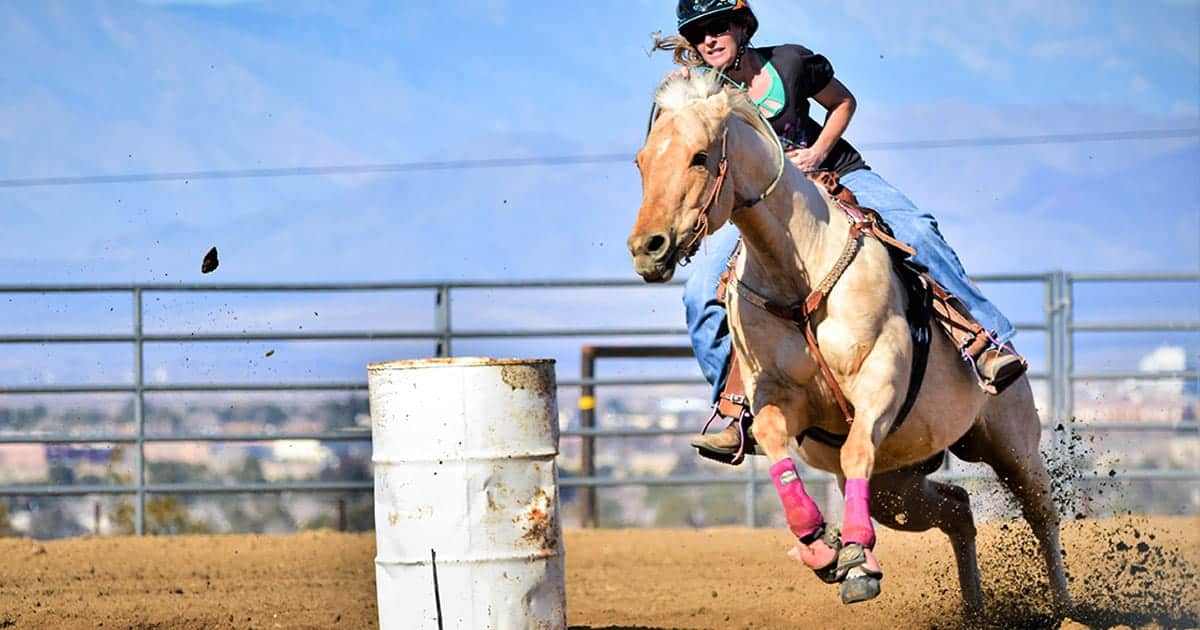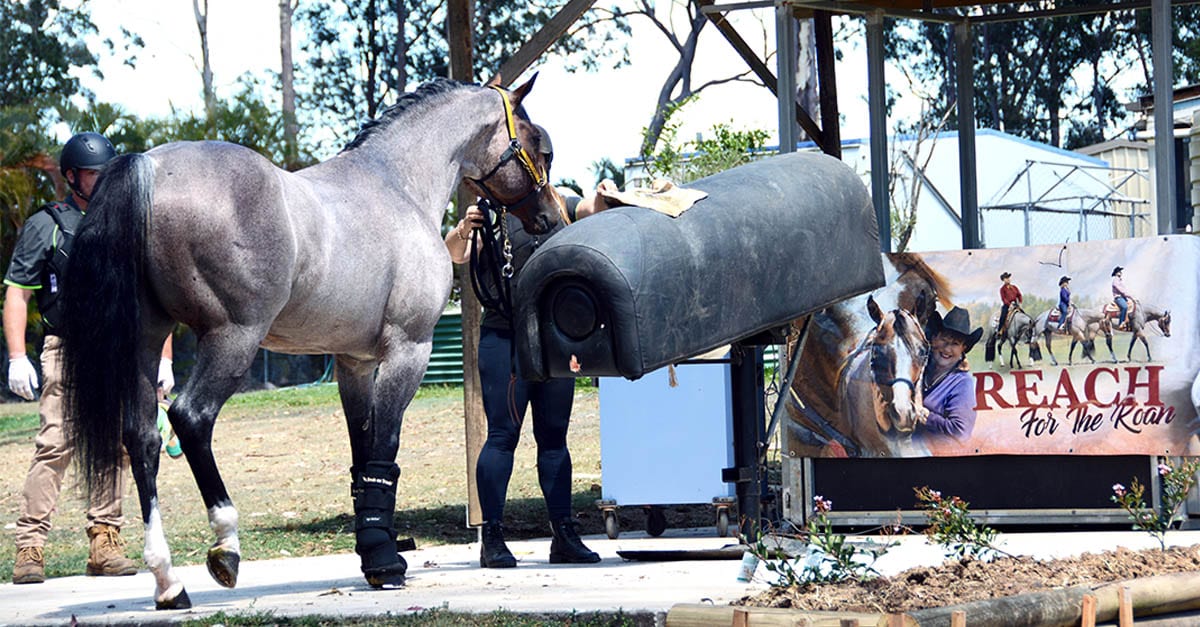Feeding sport horses
In a previous article, equine nutritionist Karen Richardson discussed the digestive and fermentation characteristics of ‘super fibre’ products (i.e. haylage, sugarbeet pulp, soyhulls) that make them more energy-dense than other fibrous products, such as hay and chaff. This month, she investigates whether super fibres have what it takes to fuel hard working performance and racing horses.
Hard working performance horses primarily rely on the metabolism of blood glucose and muscle glycogen for energy production, and replenishment of glycogen stores. As such, an abundant supply of glucose to muscle is essential to prevent fatigue and reduced performance, and facilitate recovery.
The effects of grains
Grains are fed, sometimes in large quantities (up to 16kg per day), to performance horses to meet these increased requirements for glucose. This is because grain is comprised mostly of water-soluble carbohydrates (sugars) and starch, and only a small portion of fibre.
When grain is fed, the starch is digested in the small intestine, initially by enzymes secreted by the pancreas, and then by enzymes located in the lining of the small intestine. Following digestion of the starch, the resulting simple sugars (including glucose) are then absorbed across the small intestine lining by specific transporters.
Glucose is transported via a transporter called ‘sodium/glucose cotransporter isoform 1’, or ‘SGLT1’ for short. This transporter is most abundant in the proximal small intestine. Unfortunately, whilst SGLT1 binds strongly to the sugar substrates, its capacity is low. You may want to think of the SGLT1’s as trucks that can only hold a small amount, which means the amount of glucose the equine body can absorb from starch digestion in the small intestine is largely limited by the number of available SGLT1 transporters in the body.
Unabsorbed and undigested starch and sugars will continue on to the large intestine where they are utilised by the microbes inhabiting the hindgut. This can be problematic as conditions such as laminitis, colic, diarrhoea, decreased appetite, weight loss and poor performance can be induced when large quantities of undigested starch and other carbohydrates originating from grains are metabolised by microbes of the hind gut to produce high levels of lactic acid and other volatile fatty acids.
The resulting acidic conditions can, ultimately, trigger a cascade of events affecting the dynamics of the microbial community. A condition referred to as lactic acidosis causes bacterial breakdown (lysis), which releases endotoxins (parts of the outer wall of gram-negative bacteria that elicit a strong immune response) that damage the mucosal wall of the large intestine. Subsequent absorption of endotoxins and other molecules into the bloodstream may lead to clinical consequences, including colic, diarrhoea and laminitis.
In an effort to prevent such conditions, maximise starch digestion and decrease the amount of undigested starch reaching the large intestine, it was recommended that meals containing grains be limited to about 2kg in weight. In addition, feed products, such as the ‘super fibres’, have been explored as an energy-dense feed with the ability to replace some of the grain content in the diet.
Fibrous feeds
Traditionally, fibrous feeds, such as hay and chaff, are considered to be relatively low contributors to blood glucose production, compared to grain. This is because of their relatively low levels of non-structural carbohydrates (starch and sugars), high levels of cellulose and lignin, and low levels of soluble fibres (also known as rapidly fermentable fibres, e.g. pectins).
Consequently, they are unable to sustain the high energy requirements of hardworking horses. In contrast, the ‘super fibres’ are comprised of high concentrations of rapidly fermentable soluble fibres (e.g. pectins), and lower levels of cellulose and lignin, making them highly digestible and highly fermentable by the hindgut microbes. They also contain relatively low concentrations of starch and sugars that can be digested in the small intestine.
In contrast to grain feeds, which produce a high concentration of blood glucose over a relatively short period of time, the super fibres produce a similar amount of blood glucose over a longer period of time.
Consequently, the blood glucose peak (and corresponding insulin response) is lower than observed for grain. These observations were shown by Groff et al. who reported that, whilst horses fed 750g of unmolassed sugarbeet pulp showed lower peak (maximum) blood glucose concentrations, compared to a meal of 750g whole oats, they produced statistically similar average overall blood glucose concentrations.
This is because the horses benefited from the enzymatic digestion of sugarbeet pulp non-structural carbohydrates in the small intestine, in addition to the ‘glucose-producing’ end products of fermentation of pectins in the hindgut.
Of course, an important question is, can enough glucose be produced during exercise to sustain energy levels? This is a very pertinent question since this may have a direct affect on performance. The short answer is yes.
Crandell et al. reported Thoroughbred horses undergoing an intensive standard exercise test had similar blood glucose levels when fed a diet of sweet feed (cereal concentrate), compared to when 15% of the daily digestible energy intake was replaced with molassed sugarbeet pulp.
Similarly, Palmgren Karlsson et al. reported comparable blood glucose levels during and following an intensive treadmill exercise test when Standardbred horses were fed an oat/hay/sugarbeet pulp diet (equivalent to 2.08kg oats and 1.48kg sugarbeet pulp for a 500kg horse) compared to an oat/hay diet (equivalent to 3.55kg oats for a 500kg horse).
Similar observations in plasma glucose levels were reported by Gurbuz and Coskun [49] when Thoroughbred horses undergoing an intensive exercise test were fed either an oats-containing diet or the same diet with oats replaced by 12.5%, 25% and 37.5% of dried sugarbeet pulp.
It is important to note that no negative effect of diet on performance was observed in any of the studies.
Thus, with this information in mind, the health, welfare and potential performance of the hard working performance horse may be immediately improved by reducing the grain load of high-grain diets and adding some super fibres to their daily ration.
References:
- Crandell KG, Pagan JD, Harris P, Duren SE. A comparison of grain, oil and beet pulp as energy sources for the exercised horse. Equine Vet J 1999;S30:485-89.
- Groff L, Pagan J, Hoekstra K, Gardner S, Rice O, Roose K, et al. Effect of preparation method on the glycemic response to ingestion of beet pulp in Thoroughbred racehorses. In: Proceedings of the 17th Equine Nutrition and Physiology Symposium, Kentucky, U.S.A., 31 May – 2 June, 2001, Equine Nutrition and Physiology Society; 2001, p. 125-6.
- Gurbuz E, Coskun B. Effect of dried sugar beet pulp on some blood parameters and heart rate in exercised horses. Kafkas Universities Veteriner Fakultesi Dergisi [online] 2011;17(2):191-5. Available at: http://vetdergi.kafkas.edu.tr.
- Palmgren Karlsson C, Jansson A, Essen-Gustavsson B, Lindberg JE. Effect of molassed sugar beet pulp on nutrient utilisation and metabolic parameters during exercise. Equine Vet J 2002;S34:44-9.
- Richardson, K (2016) Fibre for Performance Horses: A Review. JEVS (in publication).
- Richardson, K (2014) High energy fibrous feeds: Is there a place for them in performance horse diets? Master of Science Dissertation. Royal (Dick) School of Veterinary Science, University of Edinburgh.




















